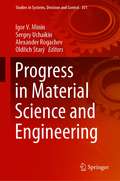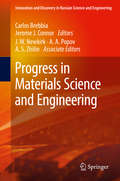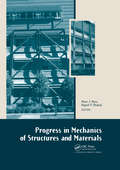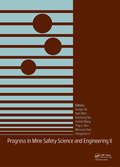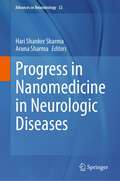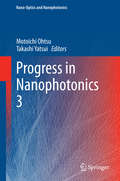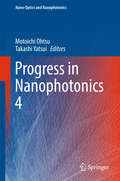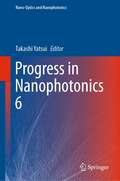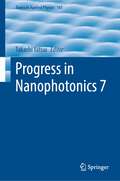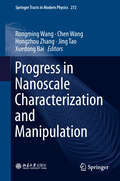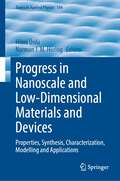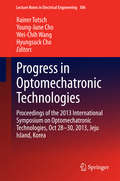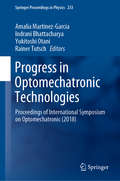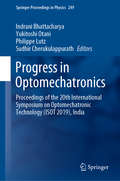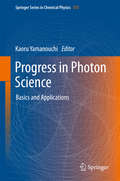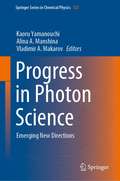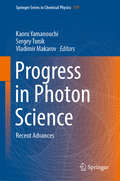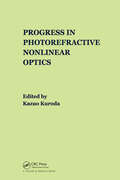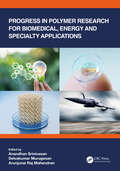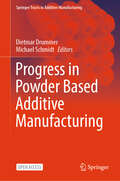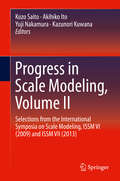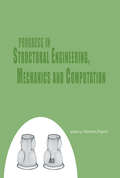- Table View
- List View
Progress in Material Science and Engineering (Studies in Systems, Decision and Control #351)
by Igor V. Minin Sergey Uchaikin Alexander Rogachev Oldřich StarýThis book presents recent developments and new directions in advanced control systems, together with new theoretical findings, industrial applications and case studies on complex engineering systems, sensors, materials science, medicine, non-destructive testing and quality assurance. With a breakthrough in technology, the modern world is on the verge of new industrial revolution, at the stage of digital transformation when innovations from various industries collaborate and change each other. Innovations are the basis of the developed products and technologies. They are used to create new developments and advances as well as improve the state-of-the-art processes. However, the digital transformation both opens new opportunities and introduces additional risks. The successful industrial modernization is characterized by the combination of stable manufacturing regulatory structure with the new technological approaches of the Fourth Industrial Revolution. Developments and advances of School of Non-Destructive Testing relate to technological trends in the areas of systems, decision making and control in the fields of aerospace systems, robotics and automation, power systems and sensor networks.
Progress in Materials Science and Engineering (Innovation And Discovery In Russian Science And Engineering Ser.)
by Jerome J. Connor Carlos BrebbiaThis book presents recent advances made in materials science and engineering within Russian academia, particularly groups working in the Ural Federal University District. Topics explored in this volume include structure formation analysis of complicated alloys, non-ferrous metals metallurgy, composite composed materials science, and high-pressure treatment of metals and alloys. The finding discussed in this volume are to critical to multiple industries including manufacturing, structural materials, oil and gas, coatings, and metal fabrication.
Progress in Mechanics of Structures and Materials: Proceedings of the 19th Australasian Conference on the Mechanics of Structures and Materials (ACMSM19), Christchurch, New Zealand, 29 November - 1 December 2006
by Peter J. Moss; Rajesh P. DhakalThis is a collection of peer-reviewed papers originally presented at the 19th Australasian Conference on the Mechanics of Structures and Materials by academics, researchers and practitioners largely from Australasia and the Asia-Pacific region. The topics under discussion include: composite structures and materials; computational mechanics; dynamic analysis of structures; earthquake engineering; fire engineering; geomechanics and foundation engineering; mechanics of materials; reinforced and prestressed concrete structures; shock and impact loading; steel structures; structural health monitoring and damage identification; structural mechanics; and timber engineering. It is a valuable reference for academics, researchers, and civil and mechanical engineers working in structural and material engineering and mechanics.
Progress in Mine Safety Science and Engineering II
by Xueqiu He Wenxue Chen Xiangchun Li Hani Mitri Baisheng Nie Yunhai Wang Ting X RenProgress in Mine Safety Science and Engineering II discusses mine safety techniques and technologies, methods and approaches, as well as problems and issues, and will be of invaluable to academics and engineers interested or involved in mine safety issues.
Progress in Mycology: An Indian Perspective
by Tulasi Satyanarayana Sunil Kumar Deshmukh Mukund V. DeshpandeIndian mycologists have extensively studied various groups of fungi such as soil fungi, aquatic fungi, marine fungi, endophytic fungi, fungi associated with man and animals. Though several books on various aspects of fungi are published, this is the first account of the history and developments in mycology in India. It discusses at length various stages of development of mycology including both classical and biotechnological aspects. It begins with a historical account of Indian mycology, followed by a description of research on fossil fungi. Further chapters cover the latest updates on different taxonomic groups of fungi. A dedicated section describes the roles and applications of fungal endophytes. The book also includes research in other important areas such as mushrooms and wood rotting fungi. Different chapters are written by leading mycologists. This book is useful to students, teachers and researchers in botany, microbiology, biotechnology and life sciences, agriculture and industries using fungi to produce various valuable products.
Progress in Nanomedicine in Neurologic Diseases (Advances in Neurobiology #32)
by Aruna Sharma Hari Shanker SharmaThis book covers the use of nanomedicine in the delivery of neuroprotective agents, including pharmacological drugs, stem cells, neurotrophic factors, monoclonal antibodies and enzymes to induce greater beneficial effects in neurologic diseases. Thus, the main purpose of the book is to explore the delivery of drugs either alone or in combination with stem cells to enhance neuroprotection in neurological diseases. Brain pathology associated with acute trauma such as head injury and brain blast injury can also be managed using novel treatment strategies. In addition, emphasis is made that standard patterns of brain pathology may be complicated with multiple comorbidity factors where one agent alone is not sufficient to induce brain protection. Enzymes and antibodies may help in combination and enhance the efficacy when administered through nanotechnology. Progress in Nanomedicine in Neurologic Diseases will encourage further research in the field of neuroprotection, brain injury, neurodegenerative diseases, neuropharmacology, neuropathology, and neurology. Students and researchers along with policy makers, teachers and health care professionals may also benefit from the findings of the book for enhanced patients care.
Progress in Nanophotonics 2
by Motoichi OhtsuThis book focuses the recent progress in nanophotonics technology to be used to develop novel nano-optical devices, fabrication technology, and advanced systems. It begins with a review of near-field excitation dynamics in molecules. Further topics include: wavelength up-converting a phonon-assisted excitation process with degenerate beams and non-degenerate beams in dye grains, a fabrication method of semiconductor quantum dots including self-assembly of InAs quantum dots based on the Stranski-Krastanov growth mode, single-nanotube spectroscopy and time-resolved spectroscopy for studying novel excitonic properties of single-walled carbon nanotubes. The striking features of ecxitons in the carbon nanotube, multiple-exciton states, and microfluidic and extended-nano fluidic techniques. These topics are reviewed by nine leading scientists. This overview is a variable resource for engineers and scientists working in the field of nanophotonics.
Progress in Nanophotonics 3
by Motoichi Ohtsu Takashi YatsuiThis book focuses on the recent progress in nanophotonics technology to be used to develop novel nano-optical devices, fabrication technology and advanced systems. It reviews light-emitting diodes and lasers made of silicon bulk crystals in which the light emission principle is based on dressed-photon-phonons. Further topics include: theoretical studies of optoelectronic properties of molecular condensates for organic solar cells and light-emitting devices, the basics of topological light beams together with their important properties for laser spectroscopy, spatially localized modes emerging in nonlinear discrete dynamic systems and theoretical methods to explore the dynamics of nanoparticles by the light-induced force of tailored light fields under thermal fluctuations. These topics are reviewed by leading scientists. This overview is a variable resource for engineers and scientists working in the field of nanophotonics.
Progress in Nanophotonics 4
by Motoichi Ohtsu Takashi YatsuiThis book presents the recent progress in the field of nanophotonics. It contains review-like chapters focusing on various but mutually related topics in nanophotonics written by the world's leading scientists. Following the elaboration of the idea of nanophotonics, much theoretical and experimental work has been carried out, and several novel photonic devices, high-resolution fabrication, highly efficient energy conversion, and novel information processing have been developed in these years. Novel theoretical models describing the nanometric light-matter interaction, nonequilibrium statistical mechanical models for photon breeding processes and near-field‐assisted chemical reactions as well as light‐matter interaction are also explained in this book. It describes dressed photon technology and its applications, including implementation of nanophotonic devices and systems, fabrication methods and performance characteristics of ultrathin, ultraflexible organic light‐emitting diodes, organic solar cells and organic transistors.
Progress in Nanophotonics 5 (Nano-Optics and Nanophotonics)
by Takashi YatsuiThis book presents important topics in nanophotonics in review-style chapters written by world leading scientists. The book sketches the history of dressed photon science and technology and explains why advanced theories of dressed photons are required. To meet this requirement, the recent results of theoretical studies and the theory of dressed photons are displayed by modifying the conventional electromagnetic theory. The classical theoretical model of spatiotemporal vortex dynamics is explained by treating the dressed photon as a space-like virtual photon. Also discussed in the book is the energy transfer of dressed photons, based on a quantum walk model and a quantum mechanical measurement process of dressed photons for connecting the nano- and macro-systems. Dressed photons are explained as quantum fields by characterizing them in momentum space.
Progress in Nanophotonics 6 (Nano-Optics and Nanophotonics)
by Takashi YatsuiThis book focuses on recent interconnected topics in nanophotonics written by scientists at the forefront of these fields. The book presents results of numerical investigations of light-matter interactions at the nanoscale and in the attosecond regime using first-principles calculations while also discussing recent experimental developments of higher-order harmonic generation for the field of attosecond science. In addition to this, the book reviews recent advances in select topical areas such as highly efficiency solid-state light sources based on nanophotonics, plasmonic photochemical water splitting for efficient energy harvesting, and optical spectroscopy of single-walled carbon nanotubes with quite rich physics for future application in photonics.
Progress in Nanophotonics 7 (Topics in Applied Physics #147)
by Takashi YatsuiAbout this bookThis book features a collection of reviews focusing on interrelated topics in nano-optics and nanophononics written by some of the world's leading scientists in these fields. The book discusses recent results of numerical investigations of light-matter interactions at the nanoscale using first-principles calculations. Additionally, it reviews selected topics in the areas of nanophotonic devices based on functional nanoparticles for energy harvesting and the development of photo materials for advanced applications in optics and nanotechnologies. Finally, the book reviews the experimental development of quantum-dot single-photon sources on integrated photonic circuits and looks at applications in quantum information processing and quantum information distribution based on color center in diamond.
Progress in Nanoscale Characterization and Manipulation (Springer Tracts in Modern Physics #272)
by Hongzhou Zhang Rongming Wang Chen Wang Jing Tao Xuedong BaiThis book focuses on charged-particle optics and microscopy, as well as their applications in the materials sciences. Presenting a range of cutting-edge theoretical and methodological advances in electron microscopy and microanalysis, and examining their crucial roles in modern materials research, it offers a unique resource for all researchers who work in ultramicroscopy and/or materials research.The book addresses the growing opportunities in this field and introduces readers to the state of the art in charged-particle microscopy techniques. It showcases recent advances in scanning electron microscopy, transmission electron microscopy and helium ion microscopy, including advanced spectroscopy, spherical-corrected microscopy, focused-ion imaging and in-situ microscopy. Covering these and other essential topics, the book is intended to facilitate the development of microscopy techniques, inspire young researchers, and make a valuable contribution to the field.
Progress in Nanoscale and Low-Dimensional Materials and Devices: Properties, Synthesis, Characterization, Modelling and Applications (Topics in Applied Physics #144)
by Hilmi Ünlü Norman J. M. HoringThis book describes most recent progress in the properties, synthesis, characterization, modelling, and applications of nanomaterials and nanodevices. It begins with the review of the modelling of the structural, electronic and optical properties of low dimensional and nanoscale semiconductors, methodology of synthesis, and characterization of quantum dots and nanowires, with special attention towards Dirac materials, whose electrical conduction and sensing properties far exceed those of silicon-based materials, making them strong competitors. The contributed reviews presented in this book touch on broader issues associated with the environment, as well as energy production and storage, while highlighting important achievements in materials pertinent to the fields of biology and medicine, exhibiting an outstanding confluence of basic physical science with vital human endeavor. The subjects treated in this book are attractive to the broader readership of graduate and advanced undergraduate students in physics, chemistry, biology, and medicine, as well as in electrical, chemical, biological, and mechanical engineering. Seasoned researchers and experts from the semiconductor/device industry also greatly benefit from the book’s treatment of cutting-edge application studies.
Progress in Optomechatronic Technologies
by Rainer Tutsch Young-June Cho Wei-Chih Wang Hyungsuck ChoOptomechatronics, as a fusion of optical and mechatronic engineering, have played a key role in developing innovative products such as high precision instruments, defence, photonic systems, measurements, diagnostics, semiconductors, and so on. And optomechatronics technologies have greatly contributed to the state of the art industries in optics design, manufacturing, optical imaging, metrology, and other applications. This book covers a multitude of optomechatronics advantages and solutions. It includes 20 contributions featuring laser and fiber optics, nitride semiconductors, LIDAR technology, machine vision, optical imaging, micro optoelectro mechanical systems, optical metrology, optical-based sensors and actuators, optomechatronics for microscopes, optical pattern and fiber, optomechatronics for bio-medical applications, optomechatronics for manufacturing applications, robotics for micro and nano scales, and other applications. As revised and extended versions, the contributed articles are selected from the proceedings of the 2013 International Symposium on Optomechatronic Technologies held on Oct 28-30, 2013 in Jeju Island, Korea.
Progress in Optomechatronic Technologies: Proceedings of International Symposium on Optomechatronic (2018) (Springer Proceedings in Physics #233)
by Rainer Tutsch Indrani Bhattacharya Amalia Martínez-García Yukitoshi OtaniThis book gathers high-quality papers presented at the International Symposium on Optomechatronic Technology (ISOT 2018), which was organized by the International Society for Optomechatronics (ISOM) and Centro de Investigaciones en Óptica (CIO) in Cancun, Mexico on November 5–8, 2018. The respective papers address the evolution of optomechatronic devices and systems, and their implementation in problem-solving and various other applications. Moreover, they cover a broad range of topics at the interface of optical, mechanical and electrical technologies and methods.
Progress in Optomechatronics: Proceedings of the 20th International Symposium on Optomechatronic Technology (ISOT 2019), India (Springer Proceedings in Physics #249)
by Indrani Bhattacharya Yukitoshi Otani Philippe Lutz Sudhir CherukulappurathThis book presents peer-reviewed articles from the 20th International Symposium on Optomechatronic Technologies (ISOT 2019), held in Goa, India. The symposium brought together students, researchers, professionals, and academicians in the field of optomechatronics and related areas on a common platform conducive to academic interaction with business professionals.
Progress in Photon Science
by Kaoru YamanouchiThis book features chapters based on lectures presented by world-leading researchers of photon science from Russia and Japan at the first "STEPS Symposium on Photon Science" held in Tokyo in March 2015. It describes recent progress in the field of photon science, covering a wide range of interest to experts in the field, including laser-plasma interaction, filamentation and its applications, laser assisted electron scattering, exotic properties of light, ultrafast imaging, molecules and clusters in intense laser fields, photochemistry and spectroscopy of novel materials, laser-assisted material synthesis, and photon technology.
Progress in Photon Science: Emerging New Directions (Springer Series in Chemical Physics #125)
by Kaoru Yamanouchi Alina A. Manshina Vladimir A. MakarovThis book summarizes the latest findings by leading researchers in the field of photon science in Russia and Japan. It discusses recent advances in the field of photon science and chemistry, covering a wide range of topics, including photochemistry and spectroscopy of novel materials, magnetic properties of solids, photobiology and imaging, and spectroscopy of solids and nanostructures. Based on lectures by respected scientists at the forefront of photon and molecular sciences, the book helps keep readers abreast of the current developments in the field.
Progress in Photon Science: Recent Advances (Springer Series in Chemical Physics #119)
by Kaoru Yamanouchi Sergey Tunik Vladimir MakarovThis second volume of “Progress in Photon Science – Recent Advances” presents the latest achievements made by world-leading researchers in Russia and Japan. Thanks to recent advances in light source technologies; detection techniques for photons, electrons, and charged particles; and imaging technologies, the frontiers of photon science are now being expanding rapidly. Readers will be introduced to the latest research efforts in this rapidly growing research field through topics covering bioimaging and biological photochemistry, atomic and molecular phenomena in laser fields, laser–plasma interaction, advanced spectroscopy, electron scattering in laser fields, photochemistry on novel materials, solid-state spectroscopy, photoexcitation dynamics of nanostructures and clusters, and light propagation.
Progress in Photorefractive Nonlinear Optics
by Kazoo KurodaThis monograph collects together papers by leading researchers in the field of photorefractive nonlinear optics. All of the works are presented by eminent researchers in their field and cover topics such as wave mixing in nonlinear optical materials; photorefractive semiconductors; organic photorefractive materials and volume holographic storage.
Progress in Polymer Research for Biomedical, Energy and Specialty Applications
by Anandhan Srinivasan Selvakumar Murugesan Arunjunai Raj MahendranWith the rapid advancements in polymer research, polymers are finding newer applications such as scaffolds for tissue engineering, wound healing, flexible displays, and energy devices. In the same spirit, this book covers the key features of recent advancements in polymeric materials and their specialty applications. Divided into two sections – Polymeric Biomaterials and Polymers from Sustainable Resources, and Polymers for Energy and Specialty Applications – this book covers biopolymers, polymer-based biomaterials, polymer-based nanohybrids, polymer nanocomposites, polymer-supported regenerative medicines, and advanced polymer device fabrication techniques. FEATURES Provides a comprehensive review of all different polymers for applications in tissue engineering, biomedical implants, energy storage or conversion, and so forth Discusses advanced strategies in development of scaffolds for tissue engineering Elaborates various advanced fabrication techniques for polymeric devices Explores the nuances in polymer-based batteries and energy harvesting Reviews advanced polymeric membranes for fuel cells and polymers for printed electronics applications Throws light on some new polymers and polymer nanocomposites for optoelectronics, next generation tires, smart sensors and stealth technology applications This book is aimed at academic researchers, industry personnel, and graduate students in the interdisciplinary fields of polymer and materials technology, composite engineering, biomedical engineering, applied chemistry, chemical engineering, and advanced polymer manufacturing.
Progress in Powder Based Additive Manufacturing (Springer Tracts in Additive Manufacturing)
by Michael Schmidt Dietmar DrummerThis open access book presents 12 years of cutting-edge research on additive manufacturing (AM), with a focus on innovative powder- and beam-based techniques. Developed through the Collaborative Research Center 814 at Friedrich-Alexander-Universität Erlangen-Nürnberg, it explores the use of laser and electron beams in transforming metal and polymer materials. From advanced strategies for selective laser melting to mesoscopic simulations of beam melting processes, this book offers a deep dive into the science behind AM. Key topics include the development of lightweight composite materials, efficient multi-material manufacturing, and optimal design of multifunctional hybrid components. Readers will also discover pioneering approaches to selective electron beam melting, reactive liquid systems for plastics, and tailored material characterization techniques. In addition, the book explores macroscopic modeling and geometric testing methods, offering new insights into the future of AM technologies. By combining theoretical advancements with practical applications, this volume serves as an essential resource for researchers and professionals in the field of additive manufacturing.
Progress in Scale Modeling, Volume II
by Kozo Saito Akihiko Ito Yuji Nakamura Kazunori KuwanaThis volume thoroughly covers scale modeling and serves as the definitive source of information on scale modeling as a powerful simplifying and clarifying tool used by scientists and engineers across many disciplines. The bookelucidates techniques used when it would be too expensive, or too difficult, to test a system of interest in the field. Topics addressed in the current edition include scale modeling to study weather systems, diffusion of pollution in air or water, chemical process in 3-D turbulent flow, multiphase combustion, flame propagation, biological systems, behavior of materials at nano- and micro-scales, and many more. This is an ideal book for students, both graduate and undergraduate, as well as engineers and scientists interested in the latest developments in scale modeling. This book also: Enables readers to evaluate essential and salient aspects of profoundly complex systems, mechanisms, and phenomena at scale Offers engineers and designers a new point of view, liberating creative and innovative ideas and solutions Serves the widest range of readers across the engineering disciplines and in science and medicine
Progress in Structural Engineering, Mechanics and Computation: Proceedings of the Second International Conference on Structural Engineering, Mechanics and Computation, Cape Town, South Africa, 5-7 July 2004
by Alphose ZingoniThe Second International Conference on Structural Engineering Mechanics and Computation was held in Cape Town, South Africa in 2004. Its mission was 'To review and share the latest developments, and address the challenges that the present and the future pose'.This book contains its key findings with contributions from academics, researchers and pra
